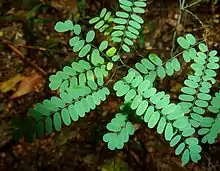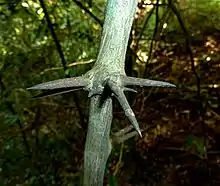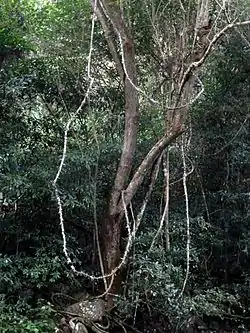Dalbergia armata
Dalbergia armata (Hluhluwe creeper) is a scrambling, deciduous species of legume that is native to subtropical to temperate regions of southeastern Africa. The robust, woody liana or small tree[2] is armed with strong spines on the main stem and branches.[3] It occurs sparsely or commonly in forest, bush, riparian fringes and in wooded ravines.[4] It is sometimes employed as a bonsai subject,[2][5] and it can be propagated from either seed or cuttings.[6]
| Hluhluwe creeper | |
|---|---|
 | |
 | |
| Scientific classification | |
| Kingdom: | Plantae |
| Clade: | Tracheophytes |
| Clade: | Angiosperms |
| Clade: | Eudicots |
| Clade: | Rosids |
| Order: | Fabales |
| Family: | Fabaceae |
| Subfamily: | Faboideae |
| Genus: | Dalbergia |
| Species: | D. armata |
| Binomial name | |
| Dalbergia armata | |
| Synonyms | |
Range
It occurs widely in coastal, montane or riparian forests of southern Tanzania,[1] Mozambique, Eswatini and eastern South Africa. In South Africa it is present in the Eastern Cape, KwaZulu-Natal, Mpumalanga and Limpopo provinces.[4] The Hluhluwe River is named after this species,[7] due to its prevalence on the banks of the river. The species is virtually confined to White’s Tongaland-Pondoland centre of endemism.[1]
Description
Their thick (up to 15 cm) and 10 to 30 m long ropes[2] have sturdy, sideways-directed spines which may grow in clusters, and encircle the stems. The spines which are up to 10 cm long,[8] hook onto adjacent vegetation to direct the plant towards the canopy. The bark is dark greyish brown.
The alternate leaves are up to 8 cm long, finely compound and are bluish green on their upper surfaces.[2] The 21 to 41[8] oblong leaflets (i.e. 10 to 20 pairs plus terminal) have a sub-opposite or alternate arrangement.[9] The leaflets close in overcast weather, and the foliage is popular with browsing animals.

Their very small,[9] sweetly scented flowers are creamy-white in colour.[2] They appear in early summer, and are born in dense terminal or axillary clusters.[9] The small and thin seed pods measure about 5 by 2 cm. They are papery in texture[3] and lemon-yellow to pale brown in colour.[2] The indehiscent fruit which hold 1 to 3 seeds each,[1] are often produced in profusion. They appear in clusters on horizontal branch tips, from late summer.[3][2]
Similar species
The Zebra-wood is also armed and has an overlapping range, but its leaflets are fewer (7 to 13) and larger, while its flowers vary from white to pink.[4] Other Dalbergia species of the region have hairy pods, or velvety undersides to the leaflets. The Thorny elm has simple leaves.
References
- Brummitt, R. K.; et al. (2007). "Dalbergia armata E. Mey". Flora Zambesiaca. Leguminosae. 3 (3). Retrieved 20 March 2014.
- Pooley, Elsa (1997). Trees of Natal, Zululand and Transkei. Durban: Natal Flora Publications Trust. p. 168. ISBN 0-620-17697-0.
- Palgrave, K. C. (1984). Trees of Southern Africa. Cape Town: Struik. p. 105. ISBN 0-86977-081-0.
- Palmer, Eve (1977). A Field Guide to the Trees of Southern Africa. London, Johannesburg: Collins. pp. 91–92. ISBN 0-620-05468-9.
- Bent, Tony. "Dalbergia". Cape Bonsai Kai. Retrieved 18 March 2014.
- "Dalbergia armata". Sunshine Seeds. Retrieved 20 March 2014.
- Raper, P. E. Hluhluwe (N 2831/2832). Retrieved 28 October 2013.
{{cite book}}:|work=ignored (help) - Van Wyk, Braam; et al. (1997). Field Guide to Trees of Southern Africa. Cape Town: Struik. p. 454. ISBN 1-86825-922-6.
- Harvey, W. H. (1894). "DALBERGIA armata E. Mey. [family LEGUMINOSAE-PAPILIONOIDEAE]". Flora Capensis. 2: 1. Retrieved 18 March 2014.